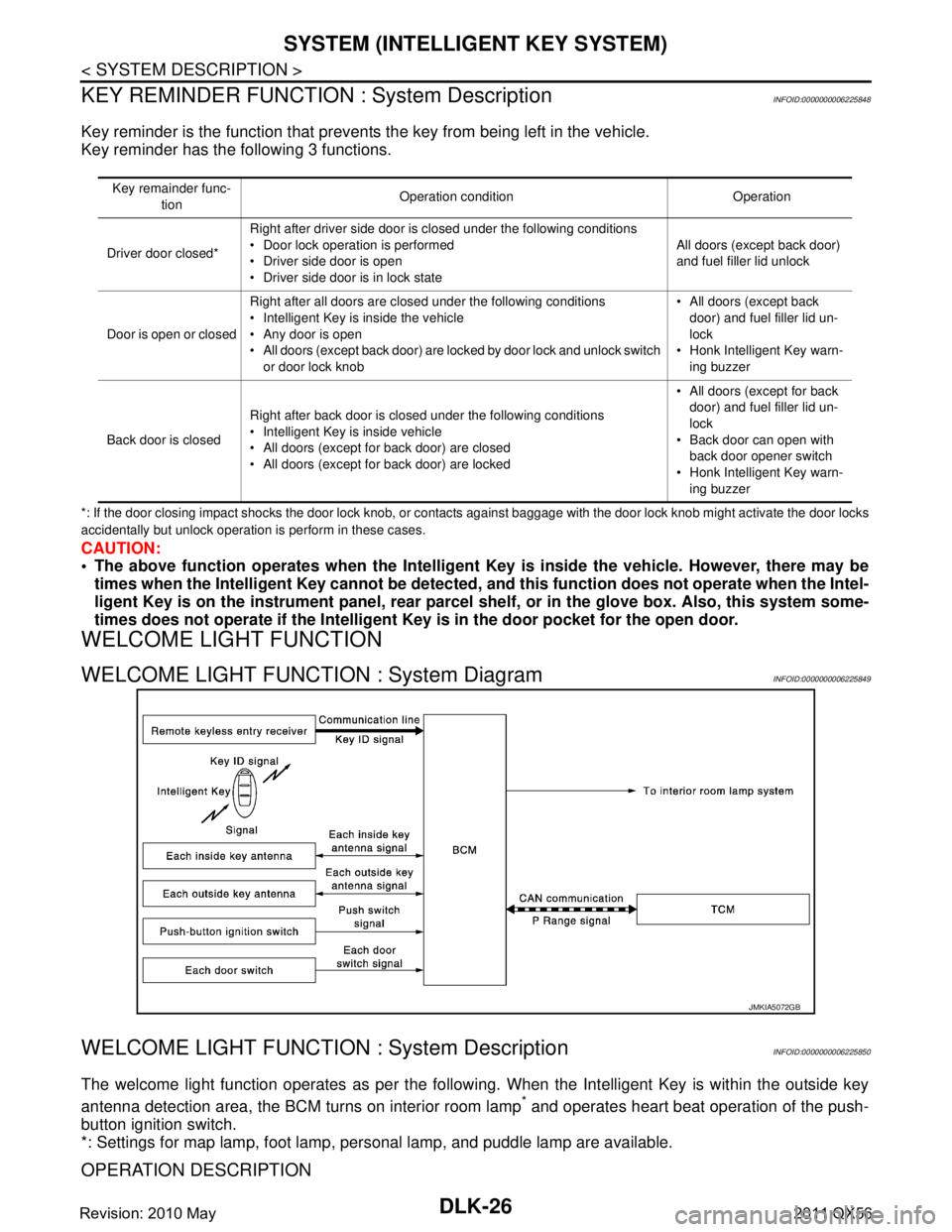2011 INFINITI QX56 instrument panel
[x] Cancel search: instrument panelPage 1562 of 5598

DLK-26
< SYSTEM DESCRIPTION >
SYSTEM (INTELLIGENT KEY SYSTEM)
KEY REMINDER FUNCTION : System Description
INFOID:0000000006225848
Key reminder is the function that prevents the key from being left in the vehicle.
Key reminder has the following 3 functions.
*: If the door closing impact shocks the door lock knob, or contacts against baggage with the door lock knob might activate the door locks
accidentally but unlock operation is perform in these cases.
CAUTION:
The above function operates when the Intelligent Key is inside the vehicle. However, there may be
times when the Intelligent Key cannot be detected, and this function does not operate when the Intel-
ligent Key is on the instrument panel, rear parcel shelf, or in the glove box. Also, this system some-
times does not operate if the Intelligent Key is in the door pocket for the open door.
WELCOME LIGHT FUNCTION
WELCOME LIGHT FUNCTION : System DiagramINFOID:0000000006225849
WELCOME LIGHT FUNCTION : System DescriptionINFOID:0000000006225850
The welcome light function operates as per the following. When the Intelligent Key is within the outside key
antenna detection area, the BCM turns on interior room lamp
* and operates heart beat operation of the push-
button ignition switch.
*: Settings for map lamp, foot lamp, personal lamp, and puddle lamp are available.
OPERATION DESCRIPTION
Key remainder func-
tion Operation condition Operation
Driver door closed* Right after driver side door is closed under the following conditions
Door lock operation is performed
Driver side door is open
Driver side door is in lock state All doors (except back door)
and fuel filler lid unlock
Door is open or closed Right after all doors are closed under the following conditions
Intelligent Key is inside the vehicle
Any door is open
All doors (except back door) are locked by door lock and unlock switch
or door lock knob All doors (except back
door) and fuel filler lid un-
lock
Honk Intelligent Key warn- ing buzzer
Back door is closed Right after back door is closed under the following conditions
Intelligent Key is inside vehicle
All doors (except for back door) are closed
All doors (except for back door) are locked All doors (except for back
door) and fuel filler lid un-
lock
Back door can open with back door opener switch
Honk Intelligent Key warn-
ing buzzer
JMKIA5072GB
Revision: 2010 May2011 QX56
Page 1746 of 5598

DLK-210
< SYMPTOM DIAGNOSIS >
SQUEAK AND RATTLE TROUBLE DIAGNOSES
If the noise can be duplicated easily during the test drive, to help identify the source of the noise, try to dupli-
cate the noise with the vehicle stopped by doing one or all of the following:
1) Close a door.
2) Tap or push/pull around the area where the noise appears to be coming from.
3) Rev the engine.
4) Use a floor jack to recreate vehicle “twist”.
5) At idle, apply engine load (electrical load, half-cl utch on M/T models, drive position on A/T models).
6) Raise the vehicle on a hoist and hit a tire with a rubber hammer.
Drive the vehicle and attempt to duplicate the conditions the customer states exist when the noise occurs.
If it is difficult to duplicate the noise, drive the v ehicle slowly on an undulating or rough road to stress the
vehicle body.
CHECK RELATED SERVICE BULLETINS
After verifying the customer concern or symptom, chec k ASIST for Technical Service Bulletins (TSBs) related
to that concern or symptom.
If a TSB relates to the symptom, follo w the procedure to repair the noise.
LOCATE THE NOISE AND IDENTIFY THE ROOT CAUSE
1. Narrow down the noise to a general area. To help pi npoint the source of the noise, use a listening tool
(Chassis ear: J-39570, Engine ear and mechanics stethoscope).
2. Narrow down the noise to a more specific area and identify the cause of the noise by:
Removing the components in the area that is are suspected to be the cause of the noise.
Do not use too much force when removing clips and fasteners, otherwise clips and fastener can be broken
or lost during the repair, resulting in the creation of new noise.
Tapping or pushing/pulling the component that is are suspected to be the cause of the noise.
Do not tap or push/pull the component with excessive force, otherwise the noise will be eliminated only tem-
porarily.
Feeling for a vibration by hand by touching the component (s) that is are suspected to be the cause of the
noise.
Placing a piece of paper between components that are suspected to be the cause of the noise.
Looking for loose components and contact marks. Refer to DLK-211, "
Inspection Procedure".
REPAIR THE CAUSE
If the cause is a loose component, tighten the component securely.
If the cause is insufficient clearance between components:
- Separate components by repositioning or loos ening and retightening the component, if possible.
- Insulate components with a suitable insulator such as urethane pads, foam blocks, felt cloth tape or ure-
thane tape. A Nissan Squeak and Rattle Kit (J-43980) is available through the authorized Nissan Parts
Department.
CAUTION:
Never use excessive force as many components are constructed of plastic and may be damaged.
NOTE:
Always check with the Parts Departm ent for the latest parts information.
The following materials are contained in the Nissan Squeak and Rattle Kit (J-43980). Each item can be
ordered separately as needed.
URETHANE PADS [1.5 mm (0.059 in) thick]
Insulates connectors, harness, etc.
76268-9E005: 100 ×135 mm (3.94 ×5.31 in)/76884-71L01: 60 ×85 mm (2.36 ×3.35 in)/76884-
71L02:15 ×25 mm (0.59 ×0.98 in)
INSULATOR (Foam blocks)
Insulates components from contact. Can be used to fill space behind a panel.
73982-9E000: 45 mm (1.77 in) thick, 50 ×50 mm (1.97 ×1.97 in)/73982-
50Y00: 10 mm (0.39 in) thick, 50 ×50 mm (1.97 ×1.97 in)
INSULATOR (Light foam block)
80845-71L00: 30 mm (1.18 in) thick, 30 ×50 mm (1.18 ×1.97in)
FELT CLOTHTAPE
Used to insulate where movement does not occu r. Ideal for instrument panel applications.
68370-4B000: 15 ×25 mm (0.59 ×0.98 in) pad/68239-13E00: 5 mm (0.20 in) wide tape roll
The following materials, not found in the kit, can also be used to repair squeaks and rattles.
UHMW (TEFLON) TAPE
Revision: 2010 May2011 QX56
Page 1747 of 5598

SQUEAK AND RATTLE TROUBLE DIAGNOSESDLK-211
< SYMPTOM DIAGNOSIS >
C
DE
F
G H
I
J
L
M A
B
DLK
N
O P
Insulates where slight movement is present. Ideal for instrument panel applications.
SILICONE GREASE
Used in place of UHMW tape that is be visible or does not fit. Will only last a few months.
SILICONE SPRAY
Used when grease cannot be applied.
DUCT TAPE
Used to eliminate movement.
CONFIRM THE REPAIR
Confirm that the cause of a noise is repaired by test driving the vehicle. Operate the vehicle under the same
conditions as when the noise originally occurred. Refer to the notes on the Diagnostic Worksheet.
Inspection ProcedureINFOID:0000000006226060
Refer to Table of Contents for specific component removal and installation information.
INSTRUMENT PANEL
Most incidents are caused by contact and movement between:
1. Cluster lid A and instrument panel
2. Acrylic lens and combination meter housing
3. Instrument panel to front pillar garnish
4. Instrument panel to windshield
5. Instrument panel mounting pins
6. Wiring harnesses behind the combination meter
7. A/C defroster duct and duct joint
These incidents can usually be located by tapping or moving the components to duplicate the noise or by
pressing on the components while driving to stop the noi se. Most of these incidents can be repaired by apply-
ing felt cloth tape or silicon spray (in hard to reach areas). Urethane pads can be used to insulate wiring har-
ness.
CAUTION:
Do not use silicone spray to isolate a squeak or ra ttle. If you saturate the area with silicone, you will
not be able to recheck the repair.
CENTER CONSOLE
Components to pay attention to include:
1. Shifter assembly cover to finisher
2. A/C control unit and cluster lid C
3. Wiring harnesses behind audio and A/C control unit
The instrument panel repair and isolation pr ocedures also apply to the center console.
DOORS
Pay attention to the:
1. Finisher and inner panel making a slapping noise
2. Inside handle escutcheon to door finisher
3. Wiring harnesses tapping
4. Door striker out of alignment causing a popping noise on starts and stops
Tapping or moving the components or pressing on them while driving to duplicate the conditions can isolate
many of these incidents. You can usually insulate the areas with felt cloth tape or insulator foam blocks to
repair the noise.
TRUNK
Trunk noises are often caused by a loose jack or loose items put into the trunk by the owner.
In addition look for:
1. Trunk lid dumpers out of adjustment
2. Trunk lid striker out of adjustment
3. Trunk lid torsion bars knocking together
4. A loose license plate or bracket
Revision: 2010 May2011 QX56
Page 1800 of 5598

DLK-264
< REMOVAL AND INSTALLATION >
AUTOMATIC BACK DOOR MAIN SWITCH
AUTOMATIC BACK DOOR MAIN SWITCH
Removal and InstallationINFOID:0000000006226131
REMOVAL
1. Remove the instrument driver lower panel LH. Refer to IP-14, "Removal and Installation".
2. Widen the pawl, and remove the automatic ba ck door main switch from switch bracket.
INSTALLATION
Install in the reverse order of removal.
Revision: 2010 May2011 QX56
Page 1802 of 5598

DLK-266
< REMOVAL AND INSTALLATION >
AUTOMATIC BACK DOOR SWITCH
AUTOMATIC BACK DOOR SWITCH
Removal and InstallationINFOID:0000000006226133
REMOVAL
1. Remove the instrument driver lower panel. Refer to IP-14, "Removal and Installation".
2. Widen the pawl, and remove the automatic back door s witch from automatic back door switch finisher.
INSTALLATION
Install in the reverse order of removal.
Revision: 2010 May2011 QX56
Page 2084 of 5598
![INFINITI QX56 2011 Factory Service Manual
EC-60
< SYSTEM DESCRIPTION >[VK56VD]
DIAGNOSIS SYSTEM (ECM)
DIAGNOSIS DESCRIPTION : Malf unction Indicator Lamp (MIL)
INFOID:0000000006217727
DESCRIPTION
The MIL is located on the instrument panel.
1 INFINITI QX56 2011 Factory Service Manual
EC-60
< SYSTEM DESCRIPTION >[VK56VD]
DIAGNOSIS SYSTEM (ECM)
DIAGNOSIS DESCRIPTION : Malf unction Indicator Lamp (MIL)
INFOID:0000000006217727
DESCRIPTION
The MIL is located on the instrument panel.
1](/manual-img/42/57033/w960_57033-2083.png)
EC-60
< SYSTEM DESCRIPTION >[VK56VD]
DIAGNOSIS SYSTEM (ECM)
DIAGNOSIS DESCRIPTION : Malf unction Indicator Lamp (MIL)
INFOID:0000000006217727
DESCRIPTION
The MIL is located on the instrument panel.
1. The MIL will light up when the ignition switch is turned ON with-
out the engine running. This is a bulb check.
If the MIL does not light up, refer to EC-515, "
Component Func-
tion Check".
2. When the engine is started, the MIL should go off. If the MIL remains on, the on board diagnostic system has
detected an engine system malfunction.
On Board Diagn osis FunctionINFOID:0000000006217728
ON BOARD DIAGNOSIS ITEM
The on board diagnostic system has the following functions.
BLUB CHECK MODE
Description
This function allows damage inspection in the MIL bulb (blown, open circuit, etc.).
Operation Procedure
1. Turn ignition switch ON.
2. The MIL on the instrument panel should stay ON.
If it remains OFF, check MIL circuit. Refer to EC-515, "
Diagnosis Procedure".
SRT STATUS MODE
Description
This function allows to read if ECM has completed t he self-diagnoses of major emission control systems and
components. For SRT, refer to EC-58, "
DIAGNOSIS DESCRIPTION : Syst em Readiness Test (SRT) Code".
Operation Procedure
1. Turn ignition switch ON and wait 20 seconds.
2. SRT status is indicated as shown blow.
ECM continues to illuminate MIL if all SRT codes are set.
SEF217U
Diagnostic test mode Function
Bulb check MIL can be checked.
SRT status ECM can read if SRT codes are set.
Malfunction warning If ECM detects a malfunction, it illuminates or blinks MIL to inform the driver that a malfunction has been detected.
Self-diagnostic results DTCs or 1st trip DTCs stored in ECM can be read.
Accelerator pedal released po-
sition learning ECM can learn the accelerator pedal released position. Refer to
EC-146, "
Description".
Throttle valve closed position
learning ECM can learn the throttle valve closed position. Refer to
EC-147, "
Description".
Idle air volume learning ECM can learn the idle air volume. Refer to EC-148, "
Description".
VVEL control sh aft position
sensor adjustment The initial position of the VVEL control shaft position sensor can be adjusted. Refer to
EC-150, "
De-
scription".
Revision: 2010 May2011 QX56
Page 2717 of 5598
![INFINITI QX56 2011 Factory Service Manual
COMPONENT PARTSEXL-7
< SYSTEM DESCRIPTION > [XENON TYPE]
C
D
E
F
G H
I
J
K
M A
B
EXL
N
O P
*1: With headlamp aiming control system (manual) models
*2: With AFS system models
EXTERIOR LIGHTING SYSTEM INFINITI QX56 2011 Factory Service Manual
COMPONENT PARTSEXL-7
< SYSTEM DESCRIPTION > [XENON TYPE]
C
D
E
F
G H
I
J
K
M A
B
EXL
N
O P
*1: With headlamp aiming control system (manual) models
*2: With AFS system models
EXTERIOR LIGHTING SYSTEM](/manual-img/42/57033/w960_57033-2716.png)
COMPONENT PARTSEXL-7
< SYSTEM DESCRIPTION > [XENON TYPE]
C
D
E
F
G H
I
J
K
M A
B
EXL
N
O P
*1: With headlamp aiming control system (manual) models
*2: With AFS system models
EXTERIOR LIGHTING SYSTEM : Component DescriptionINFOID:0000000006213888
1. Combination meter 2. BCM
Refer to BCS-4, "
BODY CONTROL
SYSTEM : Compon ent Parts Loca-
tion"
3. Optical sensor
4. IPDM E/R Refer to PCS-4, "
Component Parts
Location"
5. ECM
Refer to EC-16, "
Component Parts
Location"
6. Parking lamp
7. Front turn signal lamp 8. Front fog lamp 9. Headlamp
10. Front side marker lamp 11. Combination switch 12. Headlamp aiming switch*
1
13. Front door switch (driver side) 14.
Steering angle sensor*2
Refer to BRC-10, "Component Parts
Location"
15. License plate lamp
16. Tail lamp 17. Rear turn signal lamp 18. Rear side marker lamp
19. Hazard switch 20. Side turn signal lamp 21. Headlamp swivel actuator
22. Headlamp aiming motor 23. AFS switch*
224.Rear height sensor*2
25.AFS control unit*226.Front height sensor*2
A. Front combination lamp (back) B. View with instrument driver lower
panel (LH)C. Rear suspension member (RH)
D. View with instrument lower cover E. Front suspension arm (RH)
Part Description
BCM Controls the exterior lighting system.
ECM*
1Transmits engine speed signal to AFS control unit. (via CAN communication)
TCM*
1Transmits Shift position signal to AFS control unit. (via CAN communication)
IPDM E/R Controls the integrated relay, and supplies voltage to the load according to the request
from BCM (via CAN communication).
AFS control unit*
1AFS control unit judges the vehicle condition from each signal. AFS control unit con-
trols AFS function and the headlamp aiming.
Combination meter Outputs the vehicle speed signal (8-pulse) to AFS control unit.
Blinks the turn signal indicator lamp and outputs the turn signal operating sound with
integrated buzzer according to the request from BCM (via CAN communication).
Turns the tail lamp indicator lamp and high beam indicator lamp ON according to the
request from BCM (via CAN communication).
Turns the AFS OFF indicator lamp ON/OFF /blinking according to the request from
AFS control unit (via CAN communication).
Headlamp assembly Xenon bulb Refer to
EXL-8, "
FRONT COMBINATION LAMP : Xenon Headlamp".
HID control unit Refer to EXL-9, "
FRONT COMBINATION LAMP : HID control unit".
High beam solenoid Refer to EXL-9, "
FRONT COMBINATION LAMP : High Beam Solenoid".
Aiming motor Refer to EXL-9, "
FRONT COMBINATION LAMP : Aiming Motor".
Swivel actuator*
1Refer to EXL-9, "FRONT COMBINATION LAMP : Swivel Actuator".
Height sensor*
1
The height sensor is installed to the front suspension member and rear suspension member.
The height sensor detects the suspension arm displacement as the vehicle height change.
The height sensor transmits the height sensor signal to AFS control unit.
NOTE:
The sensor angle of the unloaded vehicle position is the reference value.
Optical sensor Optical sensor converts the outside brightness (lux) to voltage and transmits the opti-
cal sensor signal to BCM.
Revision: 2010 May2011 QX56
Page 2841 of 5598
![INFINITI QX56 2011 Factory Service Manual
OPTICAL SENSOREXL-131
< REMOVAL AND INSTALLATION > [XENON TYPE]
C
D
E
F
G H
I
J
K
M A
B
EXL
N
O P
OPTICAL SENSOR
Exploded ViewINFOID:0000000006369472
Removal and InstallationINFOID:0000000006369473
R INFINITI QX56 2011 Factory Service Manual
OPTICAL SENSOREXL-131
< REMOVAL AND INSTALLATION > [XENON TYPE]
C
D
E
F
G H
I
J
K
M A
B
EXL
N
O P
OPTICAL SENSOR
Exploded ViewINFOID:0000000006369472
Removal and InstallationINFOID:0000000006369473
R](/manual-img/42/57033/w960_57033-2840.png)
OPTICAL SENSOREXL-131
< REMOVAL AND INSTALLATION > [XENON TYPE]
C
D
E
F
G H
I
J
K
M A
B
EXL
N
O P
OPTICAL SENSOR
Exploded ViewINFOID:0000000006369472
Removal and InstallationINFOID:0000000006369473
REMOVAL
1. Insert an appropriate tool between the optical sensor and the instrument upper panel. Pull out the optical
sensor upward.
2. Disconnect optical sensor connector, and then remove optical sensor.
INSTALLATION
Install in the reverse order of removal.
1. Optical sensor
JPLIA0922ZZ
Revision: 2010 May2011 QX56